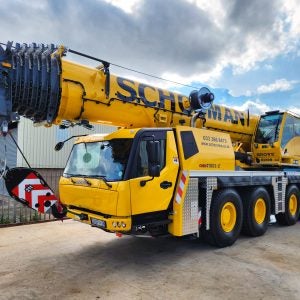The district attorney argues that the accident on East 51st Street, on 15 March 2008, was caused by Rapetti’s incorrect use of slings to hold a collar used to jump (climb) the crane. The DA says Rapetti did not use as many slings as the crane manufacturer specified, that one of the slings was damaged, and that a proper inspection would have revealed this damage.
The accident
Morgenthau said, “Rapetti, a tower crane rigger licensed by the New York City Department of Buildings, and his rigging company, Rapetti Rigging Services, were hired to erect the tower crane at a high-rise construction site at 303 East 51st Street in Manhattan. According to the New York City Building Code, only licensed riggers are permitted to oversee this type of work and they must be present at the job site whenever erection and dismantling occurs.
“On March 15, 2008, Rapetti and a rigging crew working under his supervision installed several additional sections to the mast of the tower to increase the height of the crane, in a process known as ‘jumping’. The crew consisted of Rapetti, who was directing operations from the 18th floor of the building, crane operator Wayne Bleidner, crane oiler Anthony Mazza, as well as Brad Cohen, Clifford Canzona, John Della Porta, Santino Gallone, and Aaron Stephens.
“As part of the jumping process, the crew had to install a steel collar around the mast of the crane and connect it to the 18th floor with steel tie-beams for lateral support. While the collar is being connected to the tie-beams, it must temporarily be suspended from the crane mast with slings: polyester straps with loops at each end that attach to both the mast and the collar.
“However, during the collar and beam installation that day, the four slings being used abruptly snapped, causing the collar to slide down the tower. The collar, which weighed approximately 12,000 pounds, slid down the mast and crashed into the collar at the ninth floor with sufficient force to dislodge it. The two collars then slid further down the mast and crashed into the third floor collar, dislodging that one as well, leaving the crane completely unsupported.
“The impact of the three collars violently jostled the base of the crane and caused the entire crane to tip over and collapse against the roof of an apartment building across the street on the south side of 51st Street. The top of the crane, including the cab and boom, broke away from the lower sections and catapulted over the apartment building and landed farther to the south, completely demolishing a townhouse on East 50th Street. Crane operator Bleidner and rigging crew members Canzona, Cohen, Gallone, Mazza, and Stephens died in the collapse. Odin Torres, an occupant of the townhouse demolished in the collapse, was also killed. Crew member Della Porta was seriously injured, as were John Gallego and Juan Perez, two other occupants of the townhouse.”
The slings
Morgenthau said, “Rapetti’s reckless and negligent rigging practices caused the failure of the slings and the collapse of the crane. Rapetti violated numerous provisions of the New York City Building Code, federal regulations, industry standards and the manufacturer’s specifications pertaining to the proper use of the polyester slings. In particular, one of the failed slings had substantial pre-existing damage, including cuts and severe discolouration, that would have been obvious to Rapetti had he properly inspected the sling as mandated. Because the pre-existing damage had substantially diminished the capacity of that sling, it should not have been used at all.
“All four slings had been tied to the crane in a knot called a ‘choke’, which has the weakest load-bearing capacity of the three standard knots used in this type of operation. The slings were also tied around sharp metal edges of the crane tower without any kind of protective padding, which was also a violation of the Building Code, federal regulations, industry standards and warning labels on the slings themselves. The use of the slings without protective padding caused severe cuts to the slings, greatly reducing their capacity and ultimately leading to their failure. Finally, the investigation revealed that Rapetti failed to follow the crane manufacturer’s specifications that the collar should have been supported by eight slings, not four.”
The charges
Morgenthau detailed the charges against Rapetti. He said, “Rapetti and Rapetti Rigging Services are charged with seven counts of Manslaughter in the Second Degree, a class C felony, which is punishable by up to 15 years in state prison; seven counts of Criminally Negligent Homicide, a class E felony, which is punishable by up to 4 years in prison; three counts of Assault in the Second Degree, a class D felony, which is punishable by up to 7 years in prison; one count of Reckless Endangerment in the Second Degree, a class A misdemeanor, which is punishable by up to one year in jail; and two counts of Failure to File a Return or Report, in violation of the New York City Administrative Code, an unclassified misdemeanor, which is punishable by up to one year in jail and a fine up to $20,000.”
The case against Rapetti is being brought by the rackets bureau, part of the district attorney’s office. The same prosecutors were involved in current and recent cases involving corruption in the cranes and derricks unit of the New York City Department of Buildings. The Manhattan area office of OSHA, New York’s inspector general and the New York City Department of Investigation were involved in the investigation.
Rose Gill Hearn, commissioner of the Department of Investigation, said, “The indictment announced today is the result of everything from interviews at the scene to a painstaking forensic examination by investigators and experts of exactly what caused the collapse of the tower crane.
“Some of the salient facts are that at the time of the collapse, the tower crane was approximately 250t high. The total planned height for the crane was 475ft. The boom of the crane was 120ft long. Collars weighing over 11,000lb were securing the crane to the building under construction on the third and ninth floors at the time of the collapse. An additional 5 US ton collar being installed on the 18th floor on March 15th was not properly secured causing it to fall down along the mast of the tower crane, knocking out the collar on the ninth floor.
“The process by which a tower crane is ‘jumped’ is an amazing engineering feat. It is what enables buildings of extensive height to be constructed. It is also a process that must be done with a maximum of safety precautions.”
The commissioner explained that the city has taken steps to change working practices in light of the accident. She said, “The engineer of record must now submit to a plan to the Department of Buildings (DOB) prepared by the engineer and rigger in conformity with the manufacturer’s recommendations for installation, jumping and dismantling of a tower crane. [The city has] increased training for rigging crews as well as a pre-jump safety meeting within 24 hours of each jump to review procedures, roles and responsibilities of the crew, the rigging to be used, and inspection of all equipment to be used in the jump. The DOB is auditing pre-jump meetings as well as the jumps themselves.”






